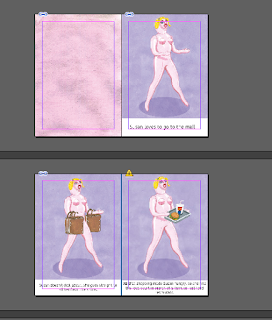The book is influenced by the two theories from my essay:
1) The uncanny - blow up dolls are similar to us in human likeness, not being able to distinguish whether it's a human or not feels us with dread - this sensation is the uncanny
2) Hybrid Consumption - The amount of activities that shopping centres provide to make you consume.

> Use of space - each illustration of the blow up doll was made smaller to emphasise on the idea of space. Seeing as space is the main focus of my essay, I thought i'd miss a trick if I didn't include it in the practical piece.
> Single person - Susan stands alone in each image, this represents what is said in Buchanan's analysis of Marc Auge's writings of the self/individualism (SUPERMODERNITY - Ego). "Anthropology now chants the lonely song of the self" (Buchanan) - everything is now about us and it's like this now than ever before.
>Non-places deal only with individuals, alone but one of many (Augé 1995). The figures in these drawing are usually singular. They are alluded to in shadows. Even when these figures are observed in groups they seem silent. There is no engagement. There is no eye contact. - Rachel Gannon on non places
> The writing - "Susan has no specific motive whilst at the mall." - this piece of writing comes from my case study. In my findings I saw that most of my participants would go to the shopping centre without having any motive
"Susan just wants to look popular." - this again comes from my case study, as one of my participants said that she would share her location so people she knows can see that she's there. It's also from Walter's concept of the flaneur, the idea that we just want to be seen shopping.

> The writing - ‘one alluring shop after another’ - Ritzer 1998 quote - backs up that shopping centres are laid out with a purpose (this being to spend the most money as possible) nothing is done at random.

> The writing - "towards a familiar chain" - familiarity is something that needed to be included in the practical. Says in Buchanan's writing about familiarity - "and as every overseas traveller knows, the familiarity of even so soulless a generic space as an airport can be comforting." This is something that people search for, as unfamiliarity is something that scares us. I found this in my case study, as some participants said that they visit the same shops when at the shopping centre because they like to stick to what they know. So I also included a brand that is universally known in the illustration as well as the writing.
> Use of food stalls - that people spend more money if they’re not feeling overcrowded (Bryman, 2004).

> Familiarity - in writing and image - tango ice blast - brand familiarity (reasoning same as above for familiarity)

> Just another element of hybrid consumption that may not seem as obvious to that of a restaurant or a cinema.

> The writing - importance of layout - nothing is put in a shopping centre at random, it is put in place to insure that the consumer stays there for as long as possible - stay longer theory. Thus having more opportunities for consumption near exits to entice you before you leave. This was seen first hand in Bluewater shopping centre, as they have a mini arcade by the exit to the carpark.

> The writing - reference to the excess of time - supermodernity
> The writing - Themed restaurants - from my case study, a participant said that they would rather go to the Trafford Centre restaurants because they are themed because it makes it a more fun and enjoyable experience. - “when people feel good they tend to want to stay longer” (Bryman, 2004).

>where the book gets more serious<
> The writing - Again, reference to excess of time - supermodernity.
> The writing - relates to my introduction of my essay - "Clouded within the milieu of the signs and symbols of the realities that the consumer must decipher, the hyper-real is often overlooked, illustrating the success of hyperreality and the difficulty that consumer citizens encounter in differentiating between the two (Koutsobinas, 2015)."
> The writing - "susan doesn't need to spend this much time..." - the message I want to get across/the purpose of my practical - to make people realise their spending habits and how they don't need to be swept under all these different consumption 'opportunities'.

Cited from essay - Cities have been built with consumerism at the forefront, making it completely unavoidable, even if one has no interest, you consume (Buchanan, 1999).
Cited from essay - "But by combining different elements of consumption, hybrid consumption changes the way in which you perceive your surroundings, that being something ‘spectacular’ (Bryman, 2004). As Bryman discloses, by doing this they ‘create extraordinaries where otherwise ordinariness reigns.’"
>Single sentence at the end reiterates point of the book - you don't need to spend all your money and time in a shopping centre.








































